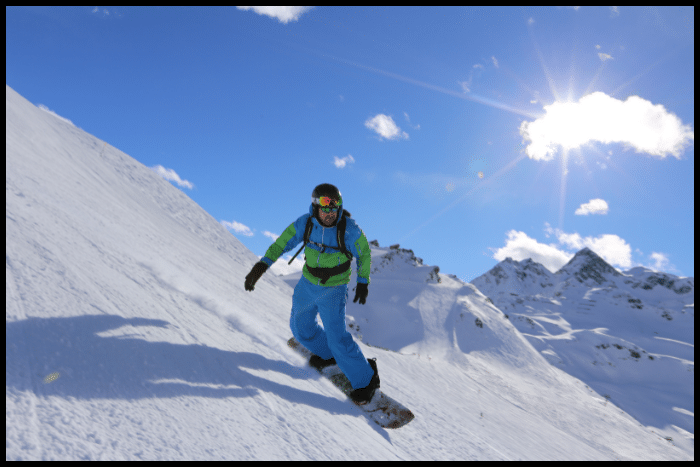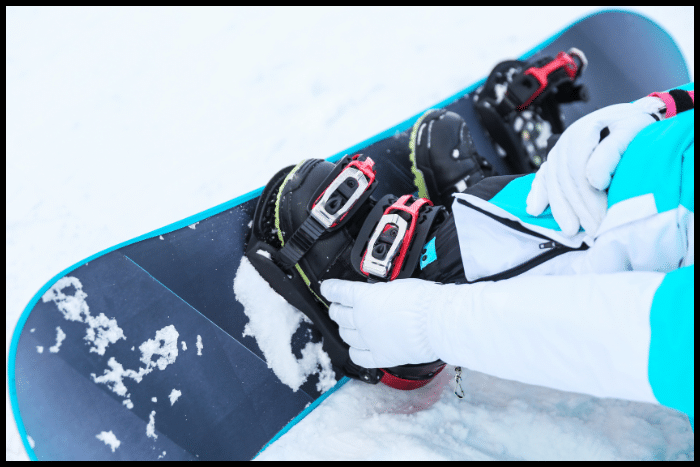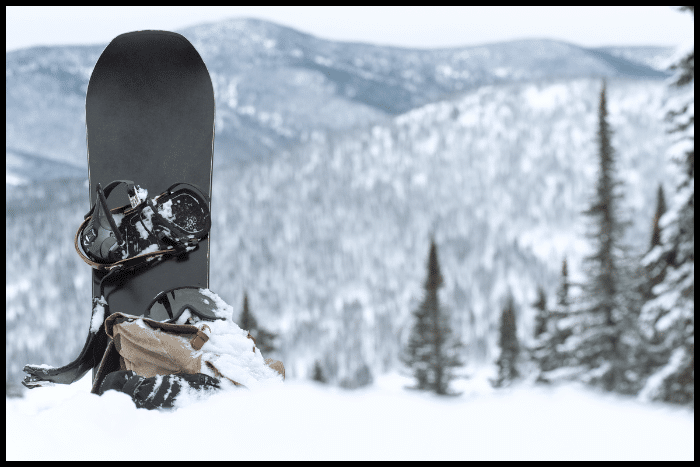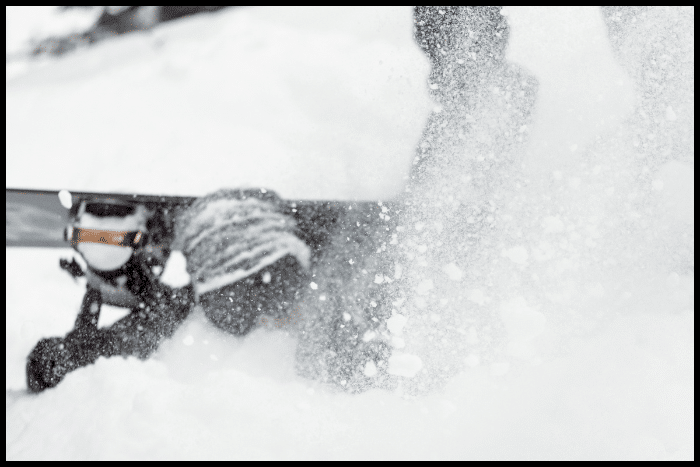You’ve seen those snowboarders zipping down the slopes, making it look like a cakewalk, and thought, “I could do that, right?” But when you finally try it yourself, you realize it’s not as simple as it looks.
Snowboarding involves using your feet and body weight to create friction between the board’s edges and the snow. This is the key to controlling the board, allowing you to navigate down the mountain and come to a stop. Performance depends on several factors, including the board’s size and shape.
Let’s dive into the nitty-gritty so you’re well-prepared when you decide to give snowboarding a whirl. Learning the specifics will help you comprehend the unique interactions between the snowboard, your body, and the surface you’re gliding on.
Demystifying Snowboarding Techniques
Snowboarding is a blend of balance, strength, and understanding your equipment. It isn’t merely about sliding downhill.
It’s about manipulating the board in such a way as to navigate the terrains and gradients of the mountain slopes safely and efficiently.
The mechanics of snowboarding are pretty straightforward, and getting a grasp on them is the perfect stepping stone to mastering the sport yourself.
It’s not just about the physical effort but also the understanding of physics and the functions of the equipment.
With time, this understanding will help you better anticipate your board’s response to your commands, making you a more effective rider.

The ABCs Of A Snowboard
Snowboarding requires a special set of skills, a deep understanding of the terrain, and an intimate knowledge of your snowboard itself.
Once you master these, you’ll find yourself not just riding down the slopes but truly experiencing the thrill and freedom that snowboarding promises.
To understand how a snowboard functions, it’s essential to know the different parts of the board.
Remember that snowboards can vary quite a bit in design, each catering to a different style or technique of riding.
1. Nose And Tail
Think of the nose and tail of a snowboard as its “front” and “back,” respectively. The nose leads the way while the tail trails behind.
There are snowboards with identical tips that let riders easily switch their leading foot and others with asymmetrical tips for styles where a change in the leading foot isn’t necessary.
The design choice caters to different skill sets and rider preferences, offering versatility in movement and style.
2. Base
The base is the “underside” of the snowboard that stays in constant contact with the snow (well until you gather enough courage to start taking on those kickers in the snowpark).
The base acts as the ‘skin’ of the snowboard, enabling it to slide across the snow with ease and speed.
Usually made from a porous, water-repellent plastic called polyethylene, the base is perfect for smoothly gliding over the snow.
Regular waxing of the base helps reduce drag and increases the board’s speed and performance.
3. Bindings
Bindings are what keep your feet securely attached to the snowboard. They’re connected to baseplates, which are screwed directly onto the board.
These baseplates are essential as they allow you to adjust the angle of your feet when riding and enable you to use the same bindings with different boards.

4. Profile
Look at a snowboard from the side, and you’ll notice it’s not completely flat. This characteristic is known as the board’s profile.
The classic snowboard profile is called “camber,” where the center is raised off the ground, and the nose and tail are bent upwards. You’ll find a variety of profiles today, each tailored to different riding styles.
I’ve covered more on this topic in my article on advantages and disadvantages of camber snowboards.
5. Edges
The edges are of utmost importance if you’re trying to understand how a snowboard works.
The edge, a thin strip of steel that surrounds the board, has two parts: the toe edge in front of your toes and the heel edge behind your heels.
Regularly sharpening these edges is vital for maintaining your board.

Let’s Talk Snowboarding: How Does It Work?
Now that we’ve covered a snowboard’s different parts let’s see how they all come together.
Snowboarders carve their way downhill, creating a weaving pattern. They control speed and direction by alternating pressure on the heel and toe edges.
The edge in contact with the snow during carving is called the “effective edge.” The board turns in the direction where the effective edge increases friction.
If you view a snowboard from the top or bottom, you’ll see the sides aren’t straight; they arc inward in a curve known as the “sidecut,” which allows the board to turn.
The length and depth of the sidecut significantly influence the board’s performance during turns. Short, deep sidecuts are great for quick, sharp turns – perfect for the snowpark or threading between trees.
A longer, shallower sidecut facilitates smoother, more gradual turns – ideal for wide, open runs where stability is key.
1. How to Stop Your Board
Before speeding down the mountainside, knowing how to safely come to a halt is crucial.
It’s an art that requires precision, control, and a deep understanding of how your actions interact with your board and the snow underneath it.
The basic principles behind braking are pretty straightforward, though they do take some practice to perfect.
You’ll need your effective edge digging into the snow, perpendicular to the slope, to stop.
You achieve this by initiating a turn and adding extra pressure with the heel or toe of your back foot (depending on whether you’re using your heel or toe edge) and bringing your turn to a halt.
If you don’t apply enough pressure, you’ll continue carving across the slope – a common sight among beginners who tend to occupy a lot of space on the slope.
2. The Dreaded Edge-Catch
Catching an edge is when the leading edge of the board digs into the snow, usually leading to an abrupt and unexpected fall – a rite of passage for every snowboarder until they master the art of carving.
Ideally, the snow should glide under the board’s base before it meets an edge.
But if the opposite happens, the snow prevents your board from moving downhill while your body’s momentum continues in the original direction, causing you to fall.
The secret to making effective turns or brakes without catching an edge lies in understanding exactly how and when to apply pressure with your heels or toes.
By applying pressure with your front foot before your back and correctly aligning your body’s center of gravity with the slope, you’ll gradually reduce the chances of catching an edge.
You can read more about it in my article on snowboarders zig-zagging and linking turns.

3. Putting It All Together
So, now you’re equipped with a basic understanding of how a snowboard works.
By manipulating the board’s edges and adjusting body posture, a snowboarder creates friction against the snow, enabling control, navigation, and safe stops down the mountain.
But remember, while theoretical knowledge is a great starting point, snowboarding is a sport that also demands a considerable amount of physical engagement and mental focus.
You can read about it all you want, but the real magic and understanding come from experiencing it firsthand.
Successful snowboarding requires two key things – practice and patience. The real test of understanding a board’s function is to hit the slopes, strap one to your feet, and experience the thrill firsthand.
Every fall, successful run, and moment spent on the board contribute to your understanding and mastery of the sport.
Conclusion
Now that you understand how a snowboard works, it’s time to embrace the thrill and join the fun. Strap on a board, take a deep breath and start carving your own path down the slopes.
Snowboarding offers an exhilarating blend of excitement, freedom, and skill, perfect for those starting their journey. Embrace the falls, celebrate the successes, and enjoy the learning process.
Explore different terrains, conquer fears, and immerse yourself in the beauty of snowboarding as you progress.
